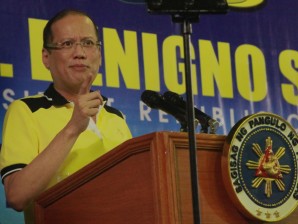MANILA, Philippines–Malacañang on Monday brushed aside objections to the government’s offer of P18,000 subsidy for each family living along waterways to rent a room somewhere else, saying President Benigno Aquino III wanted them to be safe.
Urban poor leaders have raised objections to the rental subsidy, arguing that the P360-million total cost would be better spent on permanent resettlement.
Secretary Edwin Lacierda said Malacañang would stick to this option in a bid to clear eight major waterways in the capital of close to 20,000 families by year-end. He bristled at insinuations this was a “band-aid solution.”
“You are looking at families living on top of the waterways and alongside waterways. And so, come rainy season, come typhoon season there’s a danger of them being washed away. At other times, however, they will also be exposed to dengue, leptospirosis, and other diseases,” the President’s spokesperson said in a briefing.
These are “danger zones,” and there is no question that the informal settlers had to be relocated to safer areas, Lacierda said.
“The President’s primary concern is the safety of these estero families,” he said.
“We don’t want the casualties during typhoon season to happen on a yearly basis. We want that eliminated totally and that’s the reason why we’re moving them away from the esteros or what we call the danger zones.”
Lacierda stressed that the subsidy was part of a comprehensive plan to relocate 100,000 families of informal settlers between now and 2016 when Aquino steps down.
“This is not a band-aid solution. A band-aid solution is just giving them assistance and that’s it. We have already programmed structures to be completed for these families,” he said.
The non-government organization Urban Poor Associates called the subsidy a “band-aid solution” to the housing problem. It proposed that the government relocate the informal settlers once the permanent resettlement site is ready.
The government is offering P18,000 to a family of estero-dweller so they could rent a home elsewhere for six to 12 months. Meantime, the government would de-clog the esteros and find a permanent resettlement area for them.
Local Government Undersecretary Francisco Fernandez said it was “cheaper” for the government to subsidize their rent than to rescue, evacuate and rehabilitate them after a strong typhoon.
“It’s unacceptable. It’s the easiest way to get rid of the informal sector families,” urban poor leader Filomena Cinco said by phone.
Cinco, president of the Nagkakaisang Mamamayan ng Legarda comprising 164 families living along Estero de San Miguel near Malacañang, said this was a “waste of money.”
“Why not use this money to build a permanent relocation site instead?” Cinco said of the P360-million rental subsidy for the 19,440 families of informal settlers.
Cinco said that urban groups objected to this option in a meeting with officials of the Department of the Interior and Local Government in May.
With the subsidy, she pointed out that a family of three could rent a room in a slum community for P1,500 a month for 12 months, but a bigger family of five would have to shell out P3,000 a month for six months.
Since the government was dead-set on implementing it, Cinco said they would seek a dialogue with Interior Secretary Manuel Roxas II, and if this failed, they would consider the option of mobilizing rallies against it.
“We always get blamed for everything bad that happens in Metro Manila,” she said.
Quoting Undersecretary Fernandez, Lacierda said that 500 families of informal settlers have moved out, and 1,000 more families in San Juan were about to move out. This leaves 18,500 families yet to be relocated.
“In principle, all 20,000 families will get the P18,000; and the team that is in-charge of doing this held consultations with the informal settler families and they are happy with the arrangements. They are just finalizing the details,” he said.
Fernandez had earlier said that the National Housing Authority has built 4,500 off-site housing units, and 3,500 more this year, for a total of 8,000.
“The target is to relocate all the 19,000 by the end of the year,” Lacierda said. “The projection is that we will be finishing everything by this year-end.”
Lacierda said the DILG was identifying the genuine informal settlers, as opposed to “professional squatters,” to ensure they would be assisted in their search for a room to rent.
